Something strange happened as the cargo bike made its way from Denmark. On its journey through Holland, Germany, and finally North America, it got heavier. A lot heavier. The cargo bike was born in Denmark, and Denmark still builds the lightest, strongest, and most modular cargo bikes on the market. Today, buyers come in asking for big torque and high peak wattage, forgetting that the heavier the bike, the more that power gets vaporized. A look at the numbers reveals that weight is the precondition for power. Ready for some lightweight math? Let’s dive in!
Power-to-Weight Ratio
Power-to-weight ratios measure how efficiently an object converts power into motion relative to its weight. Expressed as power output divided by weight, this ratio is crucial in determining performance across electric cargo bikes.
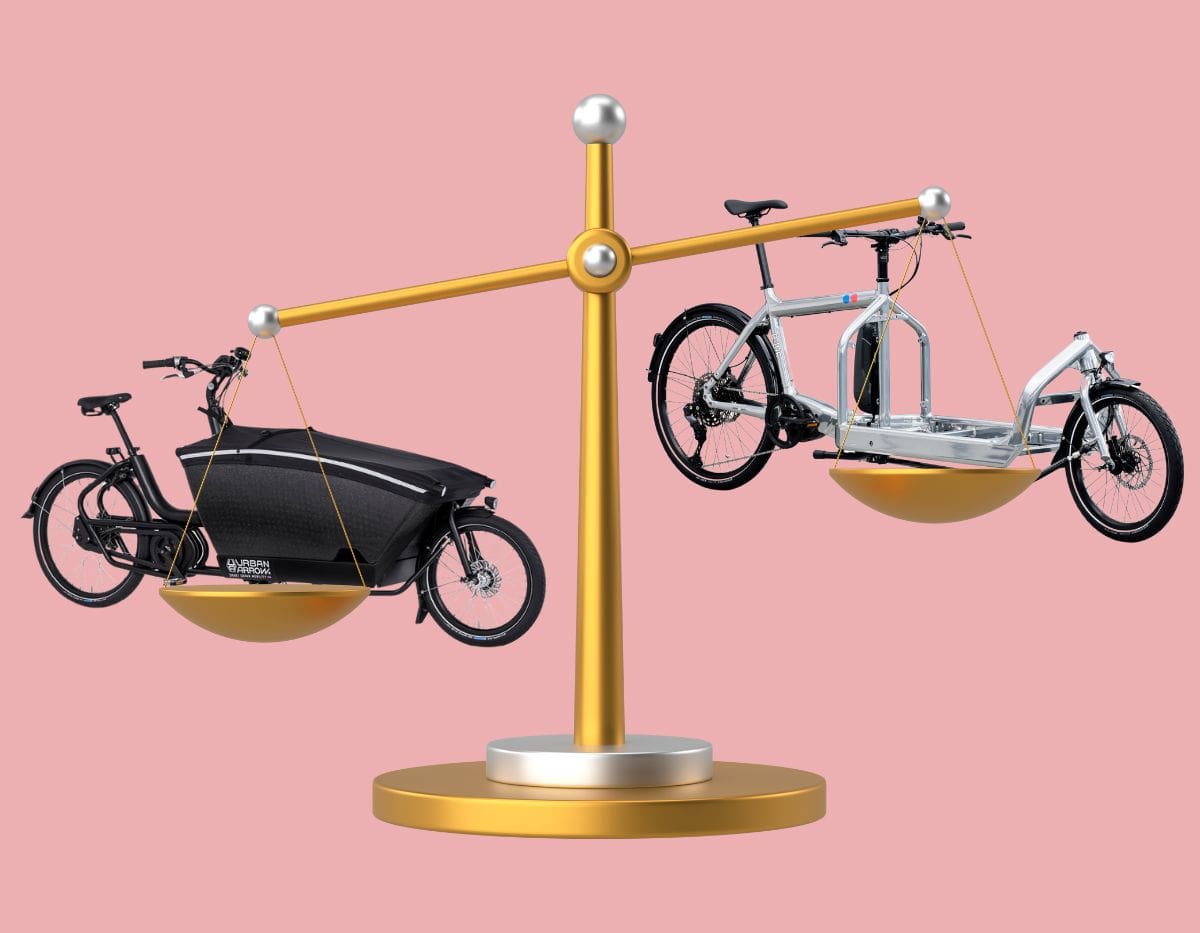
A higher power-to-weight ratio means better acceleration, efficiency, and overall speed, while a lower ratio can make movement feel sluggish, especially when climbing hills or carrying loads. In electric cargo bikes, excess weight reduces the effectiveness of motor power, making a lighter frame more advantageous for maintaining speed and extending battery life.
Lightweight Beginning, Heavy Evolution
In 2007, Bullitt became the first Danish company to mass-produce the time-honored Danish “Long John” – the world’s first two-wheeled cargo bike. Designed for speed and efficiency, a Bullitt electric bike weighs a mere 55 lbs, whereas most competitors tip the scales at 100 lbs or more. In fact, a Bullitt may be the only cargo bike you can lift, which is handy for curbs but even more important when considering the power it has compared to other brands.
Dutch Cargo Bikes: Wooden Shoes
As the cargo bike moved from Denmark to the Netherlands, it became inexplicably heavy. In 2007, the same year Bullitt began producing lightweight 45lb aluminum cargo bikes, a Dutch company called Babboe started mass-producing steel cargo bikes with heavy wooden boxes, weighing over 145 lbs. In 2023, Babboe recalled every bike they made due to structural failures.
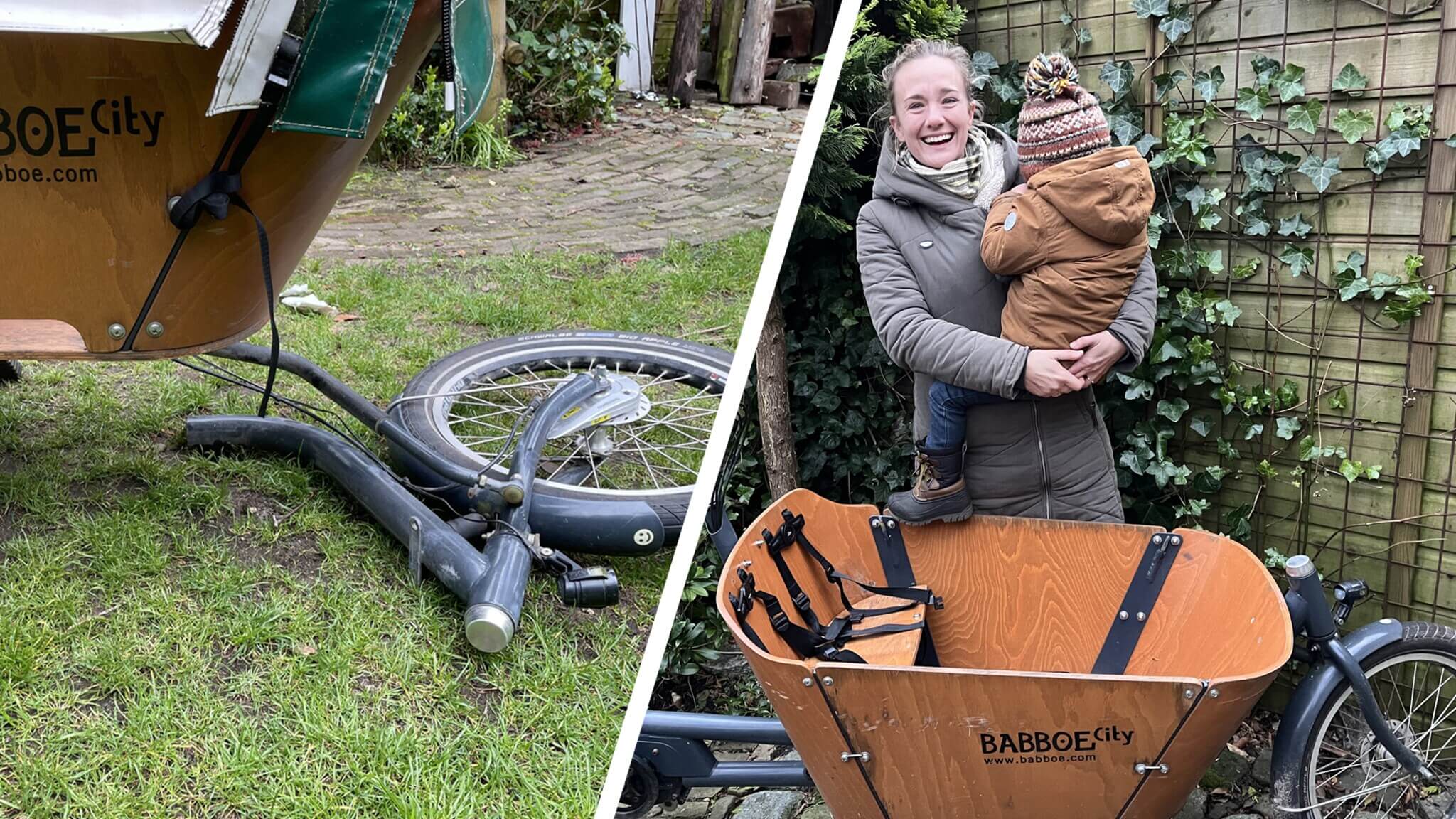
In 2011, Urban Arrow emerged as a competitor to Babboe. A Dutch brand, it took cues from Bullitt by using aluminum frames. Despite this, their bikes still weighed in at 115 lbs – double the weight of a Bullitt! The Urban Arrow may have corrected the drift when it came to Babboe, but it didn’t correct the drift when it came to Bullitt. If Bullitt is a Nike Air Max, then Urban Arrow is a wooden shoe.
Powerful Math
Now, many buyers opt for an Urban Arrow because of its high-torque Bosch Cargo Line motor. But torque alone isn’t enough if the bike is too heavy. The Bosch motor produces 85 Nm of torque, but torque (Nm) does not directly determine power without knowing the motor’s cadence (RPM). The average cadence for an electric bike is 80RPM. This is converted to radians per second (rad/s), which in the case of the Urban Arrow is 8.38. This is multiplied by 85nm which is how we determine the motors peak power of 711.9W. Finally, this is divided by the bikes weight. The final number, in kilograms, is 13.64W per kilogram. As we’ll see, this is not very powerful at all.
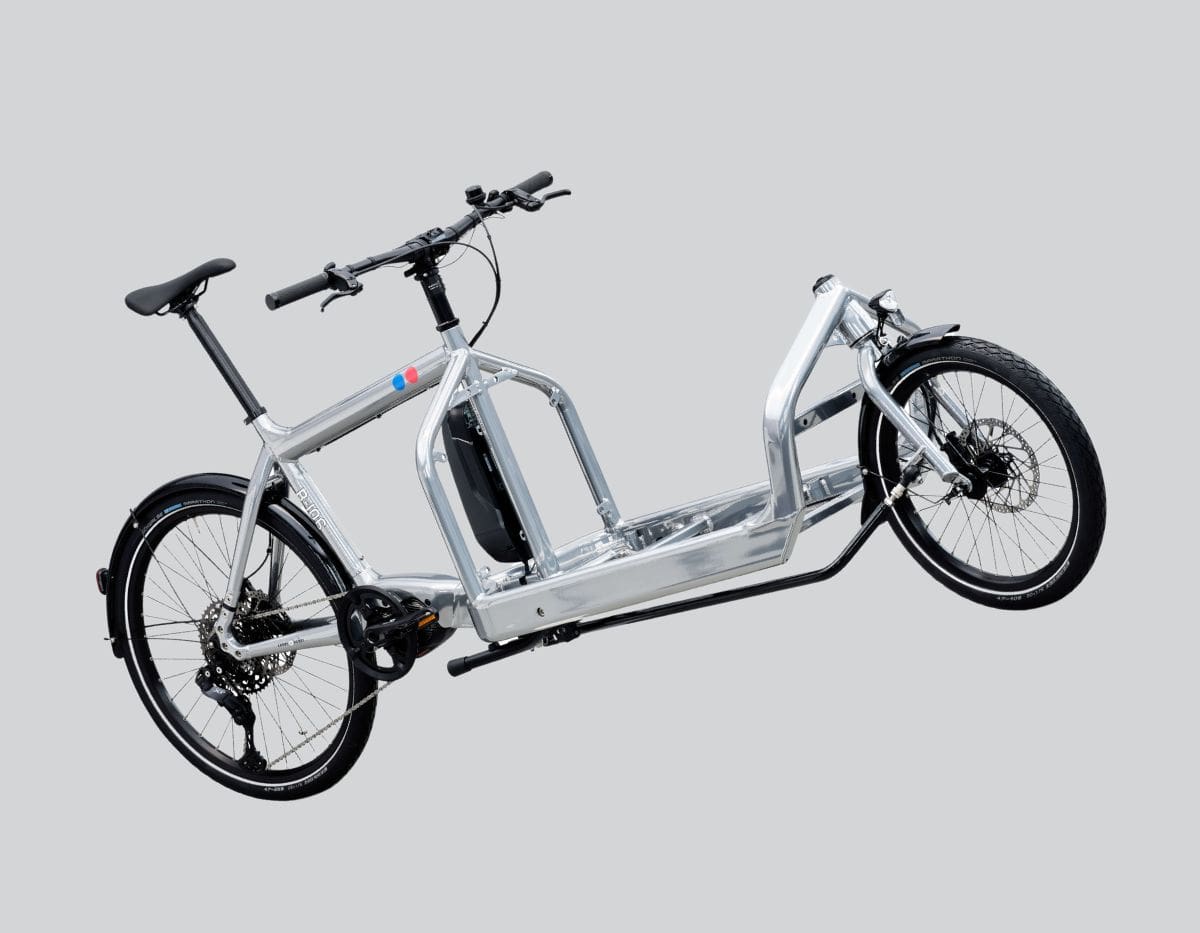
Compare that to a Bullitt E6100, which has a lower 65 Nm torque motor but weighs only 55 lbs. Its power-to-weight ratio is 21.83W per kg—a 53% increase over the Urban Arrow. Meanwhile, the Bullitt EP801, with 85 Nm of torque and the same lightweight frame, reaches 28.55W per kg—a 100% increase over the Urban Arrow. It’s hard to conceive how Urban Arrow bettered the breed.
German Cargo Bikes: Dialling Back
If the Dutch tend to overbuild, German brands like Riese & Müller tend to over-engineer. Take for instance the Load 75 model. This model features dual suspension and big battery range. Compared to the Urban Arrow, it’s an indisputable technological leap. A Load 75 weighs 84 lbs (versus Urban Arrow’s 110 lbs) and has a 725 Wh battery (versus Urban Arrow’s 545 Wh), resulting in a power-to-weight ratio of 18.47W per kg. You can’t deny Riese & Muller did something special. But, they also dialled in the weight while adding lots of extra dials. Question is: how many dials do you need?
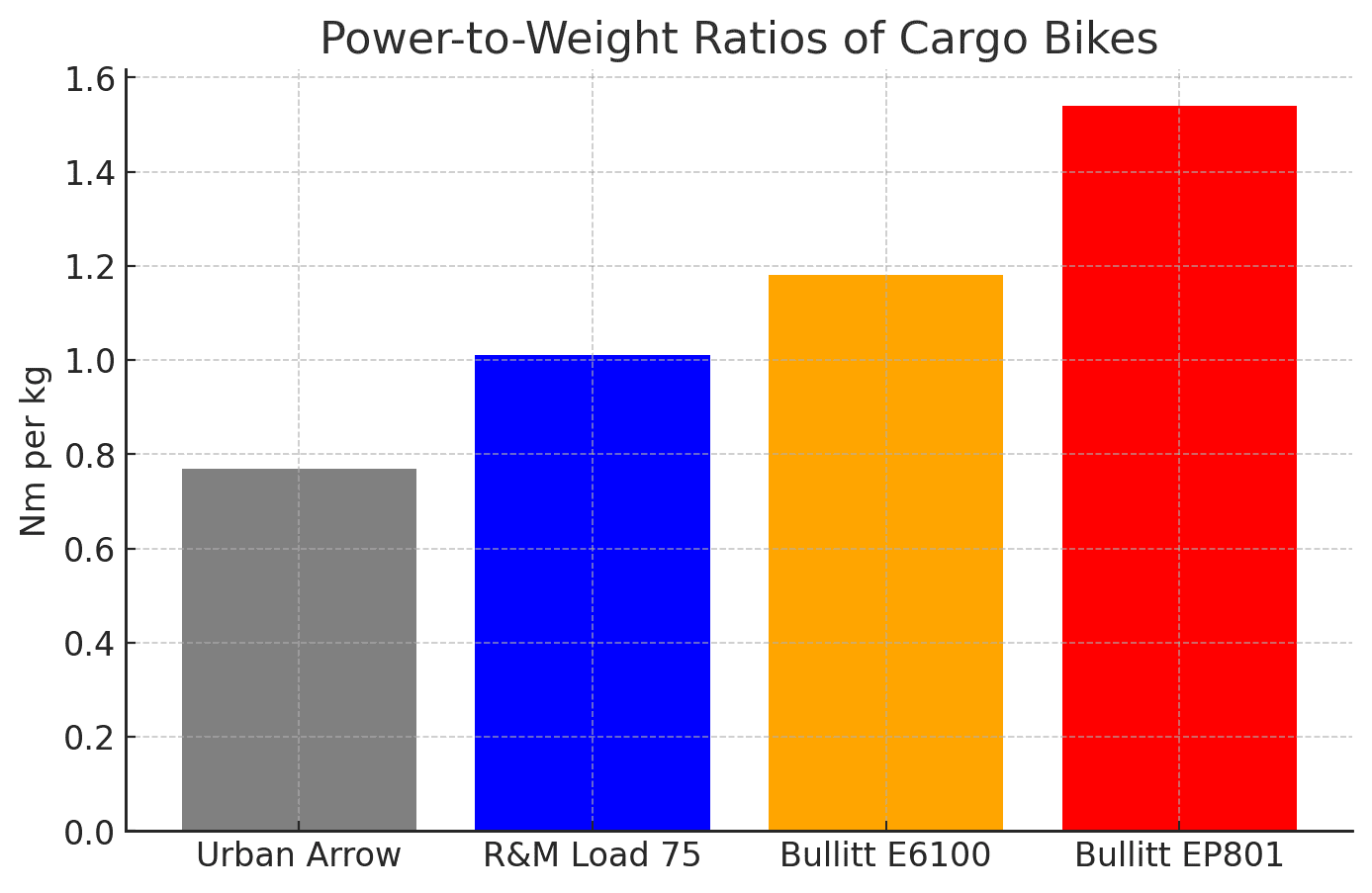
The question is whether more range or comfort is actually value-added or gimmicky. As far as comfort goes, suspension forks and swing-arms require significant maintenance, especially in winter. A simpler solution is a suspension seatpost. As for children, cushioned seating does a better job at reducing vibration than a front suspension fork – especially the cheaper suspension forks used by Riese & Muller.
Home in the Range
Many brands justify heavier bikes by upselling larger batteries with more range. But do city cyclists need massive range? Studies show that most urban trips fall within a 7.5 km radius. People move downtown to experience a high proximity lifestyle that reduces travel time. Home is not out of range from work. Work, home and play are fundamentally in the range. To get some insights into how this works, here is a chart that shows how bicycle use is distributed in Holland.
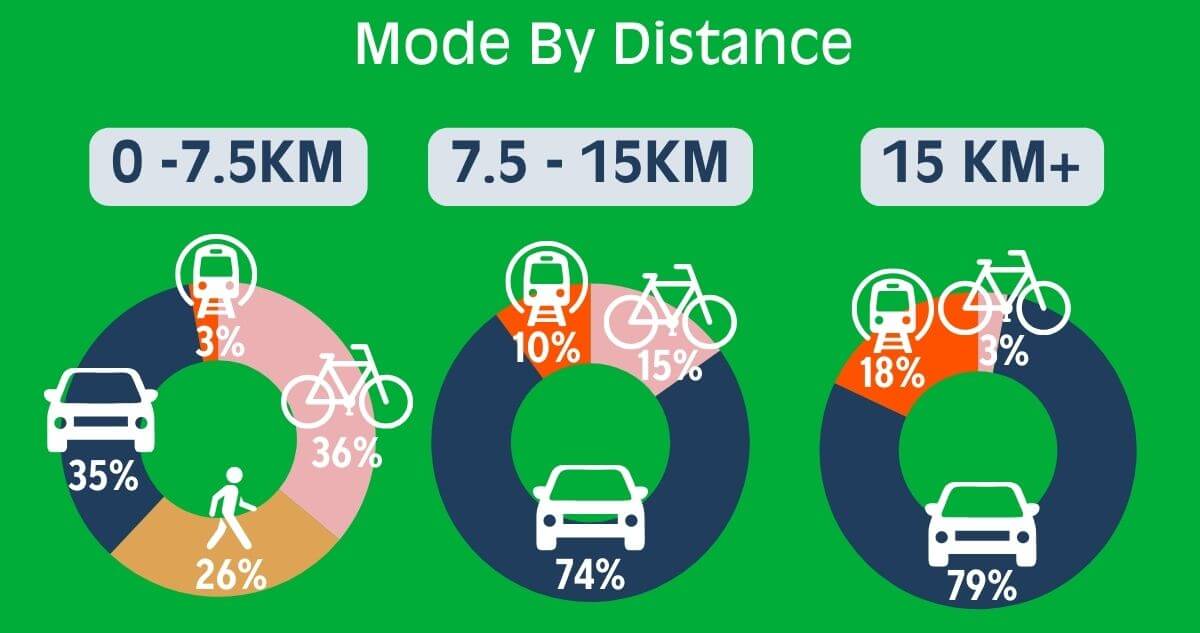
In short, bicycles out-compete automobiles where distances are short. But, within this range, power is an issue. Whereas a regular bike combines the weight of the bike, rider and some groceries, most cargo bikes can take up to 440lb in total load. If we use a Bullitt as an example, that means that a cargo bike could weigh 55lb on an empty day and 440 + 55lb on that day you dash to Home Depot to buy some cinder blocks. At minimum, the motor on a cargo bike is first and foremost there to neutralize this weight. That has everything to do with power.
Out of Range
We’re not saying range doesn’t matter, we’re just saying you already get a ton of range on most cargo bikes, especially considering that the average range of a city cyclist is under 15km per day. But, what if you want to go out of range? What if you want to do a weekend camping trip with your cargo bike?

Well, that’s no problem. A Riese & Müller Load 75, with its 725 Wh battery, can travel up to 87 km on a charge. An Urban Arrow, with its 545W battery has an estimated range of 55 km per charge. A lightweight Bullitt E6100 reaches 48 km per charge, and the Bullitt EP801 stretches to 97 km—the longest range of all four. Going further? All you need to do is buy a spare battery! It’s really that easy.
Power to Weight and Value
If all cargo bikes under discussion provide the range needed, then the real question is whether your cargo bike can handle all that cargo you want to carry. And, that’s a question of power to weight. We’ve explored the power to weight of Denmark, Holland, and Germany’s leading brands and discovered that Denmark’s Bullitt is the clear winner. But, what about value?

At a mere $7500 (at the time of writing), the Bullitt E6100 has more power to weight than any Dutch or German cargo bike and has a practical 48km of range on a battery charge. In contrast, at $10999 the Urban Arrow seems like a poor value with just 55km of range and the lowest power to weight ratio of all the bikes. And, at around $15,000 the Riese and Muller Load 75 has about 87km of range, but the Bullitt Ep801 – at $13,000 – has 97km of range and 30% more power to weight than the Load 75.
Conclusion
If the Dutch tend to overbuild and the Germans tend to overengineer, Danish minimalism offers the best of both worlds. It isn’t about austerity for austerity’s sake—it’s about eliminating excess while adding value. Durability, sustainability, and easy maintenance define Danish design, and the Bullitt cargo bike is the benchmark of this philosophy.
- Lighter than Dutch and German cargo bikes
- Stronger and more modular—ideal for families or commercial use
- Adjustable for different riding positions
- Best power-to-weight ratio for real-world riding
Questions about a Bullitt? We can help!



